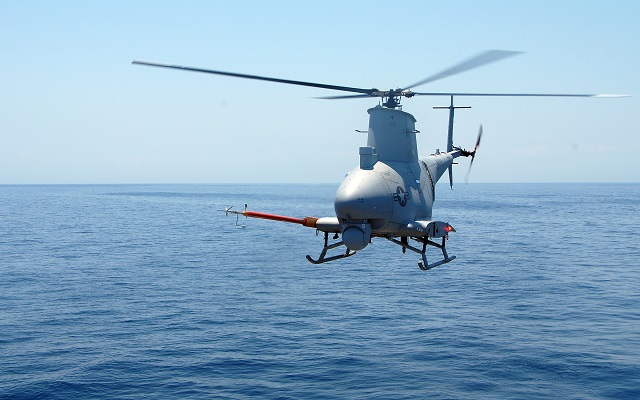
It seems like everyone's getting a drone these days. The latest kid on the block is the Navy, which is about to start experimenting with the capabilities of remotely piloted aircraft. Last week, Schiebel announced that its S-100 Camcopter
has been selected by the RAN to fulfil a requirement for the Maritime Tactical UAS Interim Capability (MTUAS-IC) project.
We're told that the interim capability is supposed to inform the acquisition of a
more substantial operational capability at a later date. The
2016 Defence White Paper IIP includes a line item for ‘$500m-$750m’ to be spent on such a capability between 2018 and 2030. The Camcopter contract includes three years of support, during which time the RAN will evaluate the potential value of a permanent MTUAS to fleet operations.
We’re pleased to see RAN experimenting with unmanned systems, because there's enormous potential for them to extend the range and effectiveness of surface vessels. But we’re also slightly puzzled and concerned. By all accounts the Camcopter's an excellent small UAS that has a minimal physical footprint in a ship’s hangar. But it's also a small, decade-old design, and it doesn’t represent the full suite of capabilities that a contemporary maritime UAV can offer. As a result, concepts of operation developed using the Camcopter could be outdated by the time the RAN acquires more capable platforms. Or it’s possible that the limited capabilities of the Camcopter will sour RAN on the idea of future investments in such platforms.
Let's hope not. There are real advantages in having UASs of various sizes in the force mix. A smaller aircraft like the Camcopter can sit alongside the manned MH-60R Seahawk in a single hangar like that on the ANZAC frigate. It'll be handy to be able to put an aircraft over the horizon to increase the ability of the ship to monitor its surrounds. And it offers some flexibility in payloads as well. The S-100 can carry a Leonardo ‘
PicoSAR’ synthetic aperture radar, or various
electronic intelligence and
optical and infrared sensors.
Being able to sustain an aircraft hundreds of kilometres from the ship (or task group) for many hours, allows a ship to be able to surveil a much greater area than is possible from its horizon-limited vantage point on the surface. One of the great advantages of operating a UAS from a ship is that it isn't limited by crew endurance, so mission duration is limited only by the vehicle's capability to stay airborne. But with a
payload of just 50 kg, the Camcopter doesn't bring a lot of capability to the table. The mission systems are capable enough for their size, but better sensors with larger apertures and more available power would yield better results in surveillance missions.
The USN seems to appreciate the advantages of larger UASs. It was an early adopter, and acquired the MQ-8B (Bravo) Fire Scout to operate from its Littoral Combat Ships (LCS) from 2009. The Bravo model has a 250kg payload and six-plus hour endurance. Enthused by the possibilities offered by the technology, the USN has since developed the even larger and more capable MQ-8C (Charlie) Fire Scout, which boasts a more than 300kg payload and 10-plus hour endurance. Both versions are also equipped with maritime search radars: the Charlie will soon be equipped with the
Osprey 30 AESA radar.
Given experience with a capable UAS, there's little doubt that the RAN could have a similar roadside conversion. But there's a question of timing. The naval shipbuilding projects are apparently full steam ahead, with steel to be cut on the offshore patrol vessels nominally next year, and the future frigates in 2020. So whatever their experience in operating the Camcopter tells the navy about the capabilities of UASs, they won't have long to ponder the ramifications for the design of the new vessels. Substantially larger UASs provide substantially more capability, but they also impose substantially greater costs in terms of space and support requirements. They won't be able to be easily retrofitted onto warships that were designed without them in mind.
We might reasonably expect some competition for hangar space on the navy's future frigates. The 2016 Defence White Paper described the vessels as being 'optimised for anti-submarine warfare' (ASW), and that necessarily means that they'll need the ability to deploy sensors and deliver effects well away from the vessel—modern submarine weapons are simply too effective for a surface combatant to risk getting too close. In order to be able to be gracefully retired as a dive wreck at the end of a long service life, a surface combatant vessel needs to be able to detect and prosecute a submarine from beyond the reach of the submarine's weapons.
The ideal ASW vessel might actually be a "mothership" that can deploy a cloud of UASs to perform sustained surveillance and—in future iterations of the UAS—release weapons when a target is identified. That's far removed from a surface combatant with a manned helicopter and all of its limitations augmented by a single small UAS. We hope the navy is thinking creatively enough about the full range of options.
 Print This Post
Print This Post